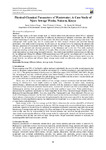Physical Chemical Parameters of Waste water. A case Study of Njoro Sewage Works, Nakuru, Kenya

View/
Date
2018Author
Chege, Bancy Gathoni
Moturi, Wilkister N.
Makindi, Stanley M.
Metadata
Show full item recordAbstract
Njoro sewage works is the main sewage work for Nakuru urban town that receives about 90% of industrial wastewater and 10 % domestic wastewater. In-sufficient pre-treatment of industrial wastewater, may affect the normal functioning of sewage works and the aquatic life (flora and fauna) of the receiving water body. The underground water aquifer may also be contaminated by both chemical elements and microbial through percolation. This study aimed at assessing the efficiency of the sewage works by analysing the physical and chemical parameters of wastewater from the inlet and outlet of Njoro sewage works. The study involved test analysis of the physical and chemical parameters in the laboratory and in-situ test. This study employed composite sampling method in the collection of samples. Data collection was done using experimental method while data analysis was done using descriptive statistics. This study found that BOD concentration was 400 mg/l for the influent and 150mg/l for effluent. COD concentration was 1399 mg/l for the influent and 222 mg/l for the effluent. DO concentrations were lower (0.05 mg/l) for influent and effluent. Traces of heavy metals were also found both for the influent and effluent. Njoro sewage works could not effectively reduce organic load in wastewater.
